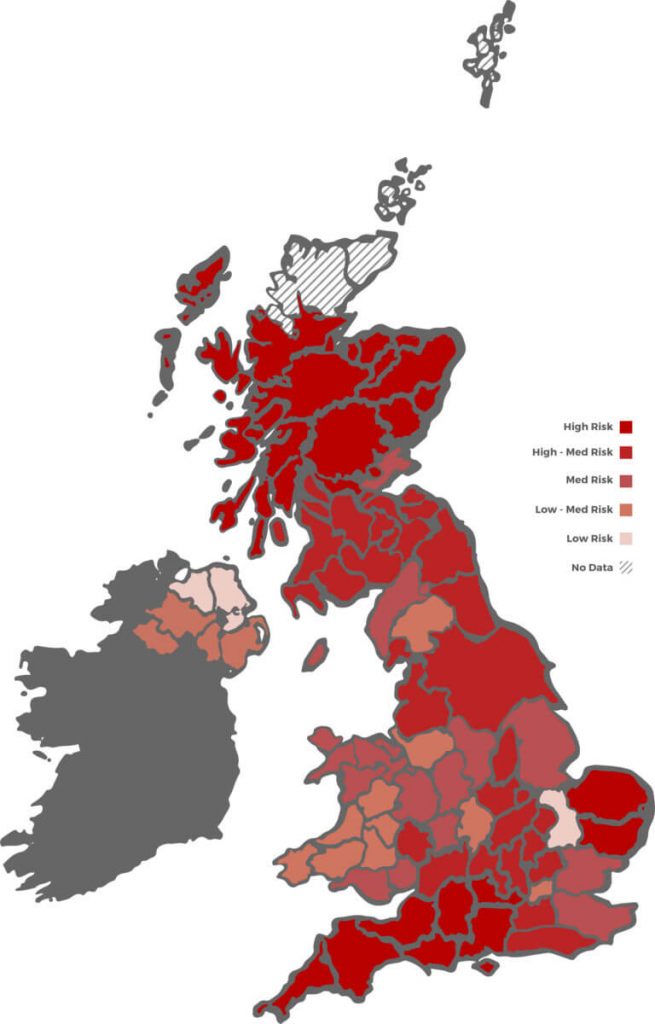May marks Lyme Disease Awareness Month, and Public Health England is encouraging people to “be tick aware”. If you work outdoors or just love spending your time doing outdoor activities, you could be at risk of contracting Lyme disease. The disease is most commonly contracted late spring – early summer, so make sure you are vigilant and quick responding in the event of a tick bite. Below is our Lyme disease UK map, showing you the areas of the UK at which you are most at risk of contracting Lyme disease from a tick bite.
UK People are at Risk of Lyme Disease

Ticks & Lyme Disease
Ticks are tiny spider-like creatures that live in woods and areas with long grass. They cannot fly or jump. Instead, they climb onto vegetation and wait for their victim to brush against the plants they’re on. They then use this as an opportunity to climb onto their future host. This is when ticks bite.
Lyme disease is a serious illness which can be spread to humans from the bite of an infected tick. Each year, more and more cases of Lyme disease are being diagnosed across the United Kingdom.
Tick bites do not hurt, and so it’s difficult to know if you’ve been bitten without seeing the tick. As a tick sucks blood, it can transfer viruses, bacteria, parasites, and even poison to their human host, which can lead to a range of moderate to severe health issues in humans. This is why it’s important to know the symptoms of Lyme disease and to seek treatment after a tick bite as early as possible.
Symptoms of Lyme disease
Initial symptoms differ from person to person, which makes Lyme disease very difficult to diagnose. Some people with Lyme disease may have no symptoms at all. For cases where there are symptoms, there are three commonly experienced phases:
Phase one – 35-50% of cases experience a Lyme disease rash. A red ring-shaped rash (called Erythema migrans) appears within three weeks at the site of the bite. This rash slowly expands, then fades in the middle and finally disappears. This Lyme disease rash is usually the first sign that you have contracted the disease.
Phase two – flu-like symptoms appear: headache, exhaustion, pain in the arms and legs. These Lyme disease symptoms are self-limiting and will disappear on their own.
Phase three (final phase) – often months after the bite, more serious and chronic Lyme disease symptoms will occur. This may include joint pain, cardiac arrhythmia and nervous system disorders.
If caught early on, Lyme disease is relatively easy to combat; a simple course of antibiotics will usually cure it. However, if left untreated or the treatment is postponed, it can be extremely serious with long-lasting symptoms.
Tick prevention
- Keep to footpaths and avoid long grass when out walking
- Wear appropriate clothing in tick-infested areas, exposing minimal areas of skin (long-sleeved shirt and trousers tucked into your socks)
- Wear light-coloured fabrics that may help you spot a tick on your clothes
- Use an insect repellent
It’s important to check your skin after you’ve returned from your travels. If you’ve got any pets or children that were with you, give them a check and keep an eye out for ticks.
Adults are usually bitten on the legs, whereas children tend to be bitten around the waist but also check their head and neck area, including their scalp. The risk of infection after a tick bite increases the longer a tick is attached, so make sure you check as soon as you get back home.
Tick removal
If you find a tick on your body, it is important that you remove the tick as soon as possible – the safest way is to use a pair of fine-tipped tweezers, or a tick removal tool.
Kays Medical supplies Care Plus® purpose-built tick tweezers which come with a step by step guide of how to properly remove a tick without leaving part of it in the skin.
Contact your GP if you begin to feel unwell and remember to tell them you were bitten by a tick or have recently spent time outdoors